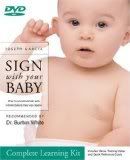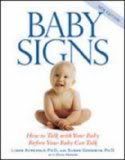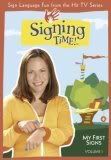
I'm not one of those people who goes ga-ga over the newborn stage. I think they're cute, don't get me wrong. But as a former cat sitter, I know that kittens, while adorable balls of fluff, are made purely of fur and energy. They're much more work than reward than an adult cat.
So it's with pleasure and anticipation that I look forward to Mikko's burgeoning skills and growth as a human. Our cat, Mrs. Pim, has not learned more than a couple new tricks since we adopted her, but Mikko is learning new things every day. And it seems like being able to communicate is what makes us uniquely human, so that's what I've been most excitedly watching for.
So, a few weeks ago, we noticed that Mikko was balling up his fist numerous times a day, as if he was waving to himself or perhaps -- our cat? Because he seemed to always wave at the cat. Isn't that cute? we thought.
A few days later, our oh-duh moment: He's SIGNING "cat."
It's a crap version of the sign, but that's my own fault. The ASL sign for cat is pretty much what you'd expect -- drawing whiskers away from the nose, like so. He has been fascinated with the cat from a very young age, so I chose it as one of our first signs. But since he'd always been looking at the cat when I thought to sign it to him, I ended up doing the whiskers somewhere out in the air, or occasionally on Mrs. Pim. So, a scrunching hand it is -- CAT. Our baby's signing.
He also uses his sign for dogs, as we found out when we visited a friend with a boxer mix. He's not particular.
What he is is consistent -- he uses it every single time he sees or hears the kitty.
Now, the next exciting news -- and I had thought the signing update would be enough for one post, but I didn't post soon enough -- is that he has now said his first word as well! And wouldn't you know -- KITTY.
Too bad (poor, beleaguered) Mrs. Pim doesn't love him back.
I recommend baby sign language both for the early-communication possibilities and for the thrill it gives you to have your baby "talking" earlier than you had hoped for. I've particularly heard that boys tend to talk later, so signing can help bridge the gap, and it's also useful for multilingual families to make concepts accessible in more than one language.
As a quick intro, start with just a couple signs, and try to mix up highly motivating and need-based signs. The need-based ones are the ones you'll want your baby to learn for your own convenience: "more," "eat," "milk," "hurt," and so on. But the motivating ones, like "kitty," "light," "truck," or "fan," are for objects or ideas they're interested in and want to talk about -- as we discovered!
You might as well go pure ASL when you can, because American Sign Language is its own language and your child might be able to learn more down the road and communicate with Deaf people. You might need to make up signs for specific concepts in your own family, but be aware that those signs won't be translatable outside of your household. Our other first sign has been "nummies," which I did make up -- it's an adaptation of the ASL for "breastfeeding," but less embarrassing. (Well, look it up and see what I mean -- Variation 2.) I wanted to retain "milk" for when Mikko's drinking cow's milk. My sign is like the sign for "breasts," as in Variation 1 above, but with an "N"-shape hand. Here's hoping I didn't inadvertently pick some real, offensive sign.
Once your baby's caught on to the first couple signs, you can race to keep up!

Photos of kids signing (helpful for seeing the signs in action on a baby -- as our experience with "cat" shows, kids' signs don't always match exactly the adult versions)
American Sign Language online dictionaries (oh, glory -- I remember when my only option was to interpret line drawings in books)
Books & DVDs
- Sign With Your Baby Kit (Book, DVD, Quick Reference Guide), by Joseph Garcia

- Baby Signs: How to Talk with Your Baby Before Your Baby Can Talk, by Linda Acredolo, Susan Goodwyn, & Douglas Abrams

- Signing Time! DVDs, with Rachel Coleman
(for you to watch, not necessarily your baby under the age of 2 -- yes, they're geared toward kids, but that makes it easy for grown-ups to learn from them!)
Comprehensive sites
And here, my friends, is a much smarter baby than mine:









 I'm Lauren Wayne, writer and natural parent. I embrace attached parenting with an emphasis toward green living.
I'm Lauren Wayne, writer and natural parent. I embrace attached parenting with an emphasis toward green living. 


0 comments:
Post a Comment